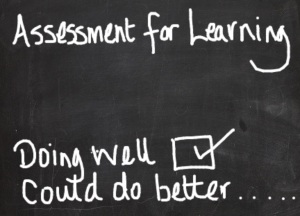Warning: Part 1 of the assessment ramblings of a TurboNerd below.
Let’s start talking assessment. Not testing….assessment. I think most would agree we OVER-test our students. It’s not necessarily our fault…after all, the current era of accountability in which we operate provides a steady drip of mandated, standardized tests that provide little to no actionable information for real-time improvement of learning. In an effort to close the gap and leave no child behind, the educational system has created a measurement monster…one that attempts to boil down the performance of teachers and students to a single metric. The desire to increase that metric for our own self-interest/preservation has spawned an entire industry of preparatory tests and a culture in which a great deal of time is spent getting students ready for TheExam®. The accountability era, while rooted in good intentions, has forced us into an environment in which we over-TEST, and, unfortunately, under-ASSESS our students. And, while it’s not our fault that we over-test our students, it IS our fault if we under-assess them. That under-assessment is unfortunate, because while testing does little to improve learning, assessing can have a powerful impact on it!
So how do we go about improving our assessment practices? Simple, we just have to take a step back and think about education’s obsession with CRAP.
Yes…CRAP.
Deep down, every successful teacher can boil their practice down to three steps. First, successful teachers can clearly identify what it is they expect their students to learn. Second, successful teachers have multiple means to determine whether or not students have attained that which was expected of them. And third, successful teachers work with those who haven’t attained it to help them close the gap. Sound familiar? Probably…especially if you are a successful teacher. And definitely if you engage in the excellent work of PLCs, or RtI, or MTSS, or the BigDeal® acronym du jour. All of these approaches are rooted in those three basic steps. Three steps to quality teaching…repackaged, renamed, and reformulated from a different perspective…but still rooted in those three basic steps. The documentation of those steps, in fact, can be traced all the way back to Ralph Tyler…in 1949.
Tyler Rationale:
- What educational purposes should the school seek to attain? (Defining appropriate learning objectives.)
- How can learning experiences be selected which are likely to be useful in attaining these objectives? (Introducing useful learning experiences.)
- How can learning experiences be organized for effective instruction? (Organizing experiences to maximize their effect.)
- How can the effectiveness of learning experiences be evaluated? (Evaluating the process and revising the areas that were not effective.)
Do those questions look familiar? PLCs, RtI, MTSS, etc…they are all valuable approaches. But they aren’t new. They’re CRAP.
Creatively Renamed Academic Practices
They are all powerful approaches. They all have the potential to help increase student learning. But, deep down, they are all simply a renaming of Tyler’s (and any successful teacher’s) practices. While I’d like to take credit for that observation, my source can be traced back to a PLC conference in 2003. I don’t know if it was DuFour or one of his colleagues that came up with it, but I think we can agree it’s true. No matter how you package a BigDeal® approach, it inevitably boils down to the three basic steps every successful teacher already knows. Three. Basic. Steps. It’s just GOOD TEACHING.
So, why don’t we do it? Well, we do….sort of. We just aren’t always intentional about bringing the three steps together in a coherent process…from the STUDENT’S perspective. That’s the necessary switch. If it helps, close your eyes and picture Sly Stallone in Over the Top…you know what I’m talking about. Turn that trucker cap around and flip the switch to structure your assessment process from the student’s perspective. THAT’S where the power of Formative Assessment comes in.
True formative assessment…not the off-the-shelf ‘formative assessment’ in a box that is ‘guaranteed’ to provide you with piles of data to help prepare your students for TheExam®. Real formative assessment…Not the weekly ‘formative’ quiz that is administered, scored, and entered in the gradebook before moving on to the next topic. Actual Formative Assessment…the process in which a student is actively engaged in those three steps from their perspective. A close look at Tyler’s Rationale suggests he wrote his steps from the perspective of the teacher. Yet even he recognized it is the STUDENT who needs to be engaged in the process: “It is what he does that he learns, not what the teacher does.” (Tyler, Basic Principles of Curriculum and Instruction).
Truly engaging in the Formative Assessment process is not rocket science…it just involves taking those three basic steps and intentionally repackaging them from the student’s perspective. Now, while it’s three basic steps, that does NOT mean it’s easy. Each of those steps requires a great deal of expertise on the part of the teacher. The steps are simple. TEACHING is not. We’ll get to that in future posts.
Thankfully, Rick Stiggins and Jan Chappuis have done most of the heavy lifting when it comes to shifting the formative assessment perspective. We’ll explore each of these steps in my next three posts. For now, I present them to you from the student’s perspective and invite you to post some ideas on what YOU can do in your classroom to shift the perspective of the Formative Assessment process from the teacher to the student.
Step 1: Set The Target(s)
- Teacher Perspective: What is it I want my students to learn?
- Student Perspective: Where Am I Going?
Step 2: Check For Understanding
- Teacher Perspective: Did my students attain the learning goals I set for them?
- Student Perspective: Where Am I Now?
Step 3: Close Any Gaps
- Teacher Perspective: How can I help them close the gap?
- Student Perspective: How Can I Close the Gap?
Diving in to each of these steps requires far more time and space than can be afforded in a single post. We’ll take a look at each one in detail over the next three updates. Until then, think about your practices. Are you intentional about bringing all three steps together in a coherent process for the students? Do they circle back to learning objectives throughout their learning? Do they self-evaluate against your learning targets after their assessments? Are they actively involved in self-reflection of their learning? If so, WooHoo! Share what you do below. If not, no worries! We can share our thoughts over the next few posts…I’ll be sure to cite LOTS of great resources! Deep engagement in the Formative Assessment Process is the single most influential practice in which I’ve engaged. I’m hopeful we can build off the successes of each other to take what we are already doing well and make it just a bit better.
Will changing that perspective be easy? Not necessarily.
Will it be worth it? Absolutely.


This year I had the opportunity to collaborate with a teacher who’s certified in both social studies and math. He taught half of his course-load in each of these disciplines and honestly, I was the beneficiary to this unusual teaching assignment. He stretched me to step away from summative assessment and delve into student reflection as a mean of assessing student progress.
I teach in a 1 to 1 iPad school, so all reflections and work are handed in electronically, however this can be translated to simple paper and pencil. In addition, this idea of student reflection as an assessment tool was used in algebra and geometry classes, but could be used for any course.
I usually do this reflection activity before a larger unit test (I know, a summative assessment, ugh!), but I find that it gets students thinking about how they study for math and also keeps them honest about what they really know, and what they think they know. We all know how easy it is for a student to say ‘oh, yeah, I know how to do that,’ while watching the teacher do an example on the board, but when the student gets that same question on a test, it’s a different story.
So here is how I do it- I set up a Google Form as a sort of survey, asking students to rate themselves on particular topics on a 1-5 scale in the beginning of class. 1- being ‘I have no idea how to do this problem,’ to 5-‘I feel very confident I’d get this question correct on the test.’ After I collect the results of the survey, we go through as a class where we think our strengths and weaknesses are.
Now, it’s time to perform…students then receive problems on each of the topics they were surveyed on. Students are to work individually. I usually don’t ask any more than 10 questions since we need to go over the answers as a class and time is always a luxury.
After we go over the answers, I then have the students write a reflection on what questions they thought they knew, but really didn’t. Where was the breakdown? What can they do to better their understanding?
We now reassess as a class where our actual strengths and weaknesses are after the reflection process- are they the same as what we discussed in the beginning of class?
I’ve found that students like this way of assessing their work. It gives them ownership of their own work and it usually leads to good class discussions.
LikeLiked by 2 people
Thanks for sharing, Jessica! I love your approach of having students reflect on their confidence for each topic! What a great way to help your students take ownership of their learning! I’ve also seen a number of examples where teachers incorporate confidence scales and reflective elements on their summative assessments…the additional information provided can lend some interesting insight into your students’ performance beyond the scores on the tests. Great reflective element that helps transform a summative test to a learning tool for the students. I look forward to hearing more of your ideas as we take a deeper dive!
LikeLike
Ideally, I would also add a step 4…
Teacher: What is student ready to learn next?
Student: What questions do I have a result of learning this?
LikeLike
Excellent point, Amy! I’ve always looped that back in to Step 1, but I think you’ve highlighted a critical component of self-reflection on the Student’s part that is missing by looping back. “What questions do I have as a result of learning this?” can build a powerful anticipatory bridge to the next set of targets. Well played!
Of course, at some point we also have to add another step with the Teacher Question: How do I report what my students learned? THAT should be a fun discussion!
LikeLike